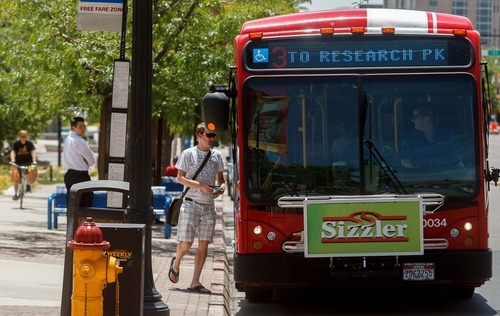This is an archived article that was published on sltrib.com in 2012, and information in the article may be outdated. It is provided only for personal research purposes and may not be reprinted.
The Utah Transit Authority is dropping its controversial efforts to eliminate its free-fare zone in downtown Salt Lake City, but will start making riders who board there either pay fares as they board or state where they are going within the free zone.
"In response to public comment and after further discussion with the Salt Lake City Council and other downtown stakeholders, we have decided to keep buses and TRAX free within the free-fare zone," UTA General Manager Michael Allegra said Wednesday. "We heard the public's concerns and have worked to come up with a solution that keeps the free-fare zone while still addressing our operational and security challenges."
UTA estimated it is losing $100,000 a year on free bus service. It also said the service increases crime by allowing unsavory people to hop on board to keep warm, or to beg or bother passengers.
The agency had agreed in a 1996 contract with the city to provide a free-fare zone downtown for 100 years in exchange for city rights of way for TRAX. With 85 years remaining on that, UTA needed permission from the city to end the free service.
UTA valued the service at $194,000 a year and offered a one-time payment to the city of $100,000 to end the service. The city said it would need equal value and had been negotiating for more.
Allegra said UTA will now change how it collects fares downtown. Until now, bus riders starting a trip within the free-fare zone were required to pay at the end of the trip, instead of at the beginning. UTA contended that allowed many to skip out on fares, or get into confrontations with drivers.
Effective Dec. 9, UTA will collect all bus fares at the beginning of trips. Riders who stay within the free-fare zone will still be able to ride for free, but they must indicate their destination within that zone as they board or pay the fare.
"Reverse-fare collection was confusing for both our customers and our operators. It will simplify the system," Allegra said. He added that bus drivers came up with the idea to charge all fares as riders board. "They like this idea. They think it's a lot more manageable."
Of note, UTA had denied an open-records request from The Salt Lake Tribune for crime data to back up its claims that the free-fare zone creates more crime. That has been appealed to the State Records Committee. Meanwhile, UTA has denied requests to discuss its crime data, how it is analyzed and how it is used to assign its police officers.
UTA never proposed to drop its more popular free-fare zone for TRAX. However, it has said that as it moves to a system to base fares on distance traveled instead of flat rates that it might then try to replace the TRAX free-fare zone — because short trips would not cost much anyway.
Salt Lake City had not been officially notified of UTA's decision Wednesday afternoon. But Mayor Ralph Becker's chief of staff, David Everitt, said the city is "sympathetic to UTA's approach on this and looking at different ways of enhancing transit downtown. We see UTA as a partner in our efforts to enhance transportation in the city."
But while some City Council members had balked at the proposal to end bus service in the free-fare zone, council Chairman Soren Simonsen said he would prefer a distance-based fare system to a free-fare system downtown.
"I'd like people to pay for their fair share of transit," he said, noting that riders pay $2.35 for short and long distances.
Tribune reporter Christopher Smart contributed to this story.



